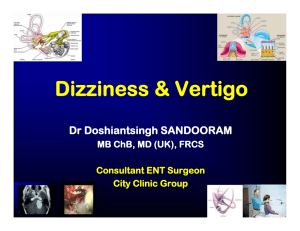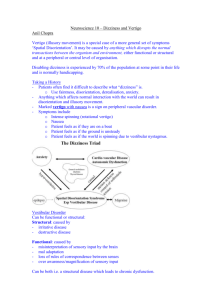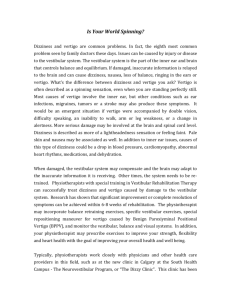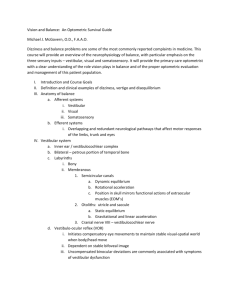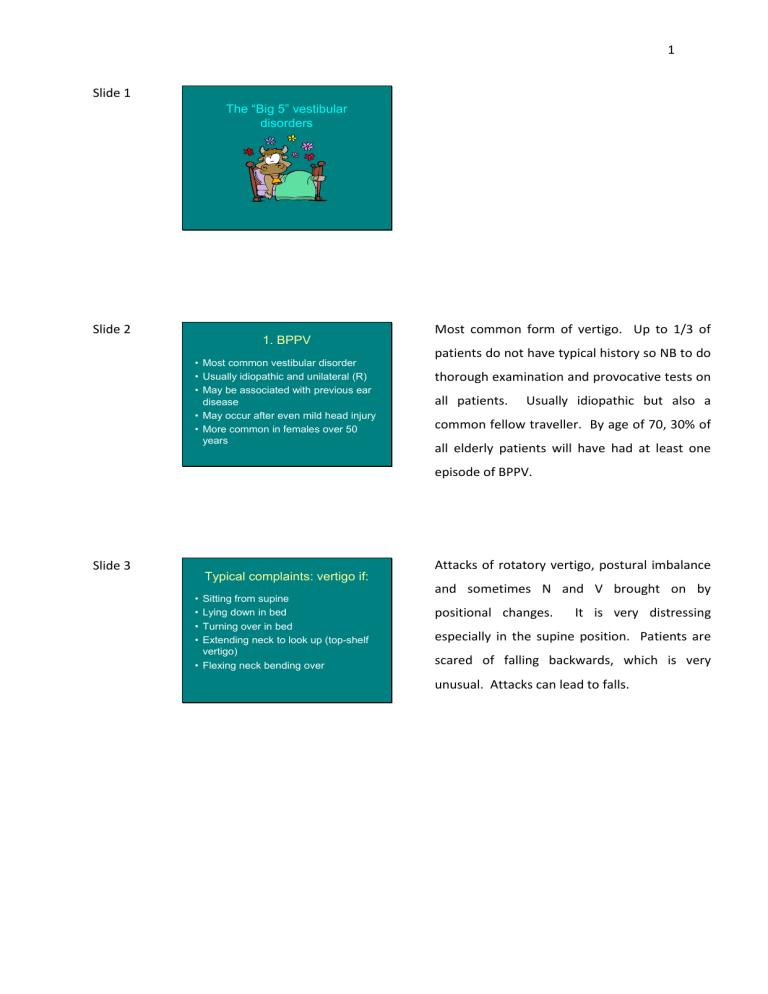
1 Slide 1 The “Big 5” vestibular disorders Slide 2 1. BPPV • Most common vestibular disorder • Usually idiopathic and unilateral (R) • May be associated with previous ear disease • May occur after even mild head injury • More common in females over 50 years Most common form of vertigo. Up to 1/3 of patients do not have typical history so NB to do thorough examination and provocative tests on all patients. Usually idiopathic but also a common fellow traveller. By age of 70, 30% of all elderly patients will have had at least one episode of BPPV. Slide 3 Typical complaints: vertigo if: • • • • Sitting from supine Lying down in bed Turning over in bed Extending neck to look up (top-shelf vertigo) • Flexing neck bending over Attacks of rotatory vertigo, postural imbalance and sometimes N and V brought on by positional changes. It is very distressing especially in the supine position. Patients are scared of falling backwards, which is very unusual. Attacks can lead to falls. 2 Slide 4 Frequency of complaints Poor balance 57% Sense of rotation 53% Trouble walking 48% Light headed 42% Nausea 35% Queasy 29% Spinning inside head 29% Sense of tilt 24% Sense of floating Blurred/ jumping vision Slide 5 Slide 6 of which would suggest BPPV 22% 15/ 13% CUPULOLITHIASIS • • • • Note the variety of symptoms reported not all First theory to explain BPPV Pioneered in 1960s Otoliths/ otoconia adhere to cupula Cupula “heavy” and responds to changes in head position CUPULOLITHIASIS Initial theory was that heavy debris settles on the cupula and this transforms it to being sensitive to linear acceleration. The theory of cupulolithiasis gave rise to the first important breakthrough treatment – Brandt-Daroff exercises. regarding 3 Slide 7 CANALOLITHIASIS • Otoconia free-floating in semicircular canal, usually posterior canal • Clot moves with head, and exerts pull on cupula • Increased firing induces an attack of BPPV Otoconia detach from the otoliths and form a clot of debris in the canal, usually the posterior SSC. The clot is denser than the endolymph and so will move to the most dependent part of the canal during head movement. The clot behaves like a plunger and exerts a Slide 8 CANALOLITHIASIS push-pull force on t he cupula and increases the firing rate of the neurons in that canal and in turn triggers an attack. Canalolithiasis is well accepted and thought to provide answers to most of the features of an attack of BPPV. It is now thought that cupulo- and canalo-lithiasis exist along a continuum. Slide 9 Tests • • • • • ENT, neuro-otological, audio exam Dix Hallpike affected ear first Use Frenzels Instruct patient to improve compliance Position relatively rapidly for maximum effect (can be brought to sitting more slowly) Dix Hallpike is gold standard for diagnosing BPPV – sensitivity is 82% and specificity 71%. There are variations on the test for obese patients or patients with neck and back problems. Although it is very difficult for humans to suppress torsional nystagmus, the test can be enhanced by using Frenzel lenses. Remember that the disorder cycles through active and inactive stages and so if the DixHallpike is negative then check the other canals and bring the patient back again. There is no need for special investigations such as VNG. 4 Slide 10 DIX-HALLPIKE Examination technique for a right sided, posterior canal BPPV Slide showing conventional positioning and modification. Bronstein A M J Neurol Neurosurg Psychiatry 2003;74:289293 ©2003 by BMJ Publishing Group Ltd Slide 11 Features of BPPV post provocative test: • Latent period • Rotatory nystagmus beating towards the under-most ear if posterior canal • Builds in intensity then decreases within 60s • Symptoms and signs diminish on repeat • Nystagmus changes direction with position Delay in onset of symptoms and signs from 1 to at least 40 seconds after the patient has been positioned. Nystagmus appears with the same latency as the vertigo – if posterior BPPV will be with the fast phase towards the undermost ear. Nystagmus builds up in intensity, peaks and then decreases and disappears within 60s. Slide 12 MANAGEMENT OPTIONS • Await spontaneous resolution • Medication completely ineffective (but disappointingly still in texts) • Re-positioning/ physiotherapeutic techniques:, CRP, Brandt- Daroff, Semont • Surgical options for rare intractable cases BPPV has a self-limiting course but can take months or years to settle. In addition the anxiety and apprehension patients feel should prompt treatment. Medication has no place in the treatment of this mechanical disorder but is still very frequently prescribed. Therefore the best option is to try to manoeuvre the clot into an area where it is no longer able to cause symptoms, which can repositioning procedures. be done with 5 Slide 13 CANALITH REPOSITIONING PROCEDURE • Pioneered by Epley in 1980s • Repositions clot of otoconia into utricle where it can no longer provoke symptoms • Many variations on original technique • Suitable for posterior and anterior canal BPPV The two most commonly used here are the CRP and Brandt-Daroff exercises. It’s important to give the patient a good explanation of the pathology and warn the patient that even with successful treatment there will be a reoccurrence in about a year in up to one third of patients – this helps to reduce anxiety. Slide 14 RESULTS • Highly successful, once-off office based procedure • Post-treatment instructions not necessary • Need to review after one week • Can be repeated then if unsuccessful initially • Relapse common Very important to review the patient about 10 days after treatment was given – and to do a repeat Dix Hallpike – need to make sure that the BPPV has cleared and not been pushed into another canal. Can repeat then. DO NOT give repositioning and Brandt-Daroff at the same time – one or the other! Slide 15 BRANDT-DAROFF EXERCISES • Based on theory of cupulolithiasis • Patient performs them as a home programme • Duration of treatment about two weeks • Also very effective if patient complies! Can be helpful in bilateral cases. 6 Slide 16 SO… • Common form of vertigo • Easily, successfully and costeffectively treated in rooms • Happy clinician, grateful and relieved patient Slide 17 2. VESTIBULAR NEURITIS • second most common cause of vertigo • Most likely that the neurite rather than the ganglion cells are affected Slide 18 Superior VN • prolonged vertigo, N & V, slow improvement over weeks • May have high frequency SNHL • Followed by recurrent episodes of severe vertigo Patient obviously ill, the intensity of the vertigo is severe and it can be followed by recurrent episodes of severe vertigo, leading to confusion with Meniere’s. It can also be followed by BPPV quite frequently. Commonly the acute vertigo is replaced by dysequilibrium which can last for many months compensation is complete. until dynamic 7 Slide 19 Inferior VN • More subtle onset, floating, rocking, pulling sensations • Visual sensitivity to movement noted • Comprises about 1/3 of all VN cases, often not documented as do not see healthcare professionals Slide 20 Combined superior & inferior VN • Severe, catastrophic vertigo (vestibular crisis). Pt very ill • Remains markedly incapacitated by severe vertigo • Takes many months to recover even with VRT Slide 21 Clinical syndrome of VN • • • • Spontaneous nystagmus Usually no auditory symptoms Commonly preceded by URTI Viruses include rubeola, reovirus, CMV and neurotropic strains of flu Much less impressive than superior nerve vestibular neuritis. Symptoms are triggered by movement and visual sensitivity to movement is present. The vertigo is profound and catastrophic with the patient being at risk of dehydration. Even with significant sedation the vertigo remains incapacitating. The type and intensity of vertigo will depend on which aspect of the nerve is affected. There will be postural imbalance with falls on the Romberg in the acute stage. Must be nystagmus in the actue stage which will be horizontal-rotatory. There will be nypo- or non-responsiveness to caloric stimulation in the affected ear. It can occur in epidemics and affects adults mainly between 30 and 60. There is a gradual recovery which depends on if the loss is partial or total, and which aspect of the nerve is affected. Common causative virus include rubeloa, reovirus, and stains of influenza, CMV and herpes simplex. 8 Slide 22 Diagnosis • Made on assessment of acute vestibular tone imbalance • Need to be careful with differentials Diagnosis rests on the assessment of acute loss of vestibular tone and that neurological disorders can be excluded. This method lacks selectivity, so pathology other than vestibular neuritis which causes an acute loss of vestibular function can be overlooked or incorrectly labelled. Consideration should be given to vascular events, MS etc. Slide 23 Tests • Audio to exclude other diagnoses Once again audio is a critical step in differential diagnosis and should be a full assessment • Inspect for nystagmus with Frenzels including reflexes and electophys evaluations • Calorics can be very helpful as indicated. Need to look with Frenzels as can • If concerned about vascular events then MRI etc miss nystagmus as it settles – or indeed when acute due to the cerebellar clamp being in place. Calorics will be helpful to identify which side and to reveal any underlying nystagmus which would otherwise be missed. Slide 24 Natural course • Sudden onset vertigo, ill++, vertigo settles slowly on bed rest • Nystagmus persists for weeks O/E with Frenzels • Most recovered within 6/52 • Even if calorics suggest improvement, this does not correlate with symptoms! About 1/3 of patients will remain symptomatic on long term follow up due to incomplete compensation. Compensation is interfered with by prolonged and inappropriate use of medication and patients not pushing due to continued symptoms – which becomes a vicious cycle. 9 Slide 25 Rx of VN • • • • Vestibular suppressants in acute stage NB Withdraw asap Steroids helpful, acyclovir not Physio – strategies of substitution; habituation, balance and gait training • Long term resolution can be very poor Lots of discussion in the literature. Vestibular sedatives and anti-emetics are only useful in the initial stages. Tapering dose of steroids is very helpful if given early in the clinical course – but there is no evidence to suggest anti-viral medication contributes anything. Steroids are also thought to have a positive effect on compensation. Refer for physio as soon as the N and V settles. Slide 26 3. Ménière’s syndrome & Disease • Classical triad of symptoms Classical triad should make it easy to diagnose – but it is grossly over diagnosed especially in the GP community. Should only be labelled when a • Very over-diagnosed (!) but third most common disorder hearing loss is evident – and there are • Can be associated with drop attacks disadvantages to labelling it too early! Note • Mechanism is endolymphatic hydrops that its prevalence does vary geographically. If Meniere’s is idiopathic, then the term MD is used. Other causes can include trauma, postinfection such as after mumps or measles, late stage syphilis, and immune-related inner ear diseases. About 6% will go on to develop drop attacks. Bilateral disease will develop in 3060% of patients. Differential diagnosis includes vestibular migraine, vascular attacks and vestibular neuritis. 10 Slide 27 Typical attack • Fullness in ear, reduced hearing • Tinnitus increases • Severe to incapacitating rotatory vertigo – 20 minutes to several hours • Postural imbalance • Grade III Nystagmus • Associated N & V Slide 28 Categorising Ménière’s Disease • “Certain” on histopathologic confirmation Nystagmus usually beats away from the affected ear during the attack, but will change direction as the attack moves from an irritative type of nystagmus to a paralytic type. Note that hearing loss and tinnitus or aural fullness must be present before being labelled as definite or even probable. • “Definite” two or more attacks >20 mins; documented HL, tinnitus and fullness, other causes excluded • “Probable” as above, only 1 attack needed • “Possible” episodic vertigo without HL Slide 29 Audiologic findings • • • • • Early stage: no loss Severity of loss variable Associated diplacusis and recruitment Glycerol test +ve in about 60% ECochG better if patient has aural fullness Patients will complain of diplacusis. Recovery of the loss may take hours in early MD or several days or months if the episode is severe. There are 3 patterns of loss – low frequency SNHL rising to normal at 2K and then a high frequency loss; or_a flat, moderately severe loss between .5 and 3k; or in patients with bilateral disease, an asymmetry of >25dBHL. Most of the deterioration happens in the early stages. 11 Slide 30 Staging MD • Stage 1: 4 frequency PTA = ≤ 25dBHL • Stage 2: PTA 26 – 40dBHL • Stage 3: PTA 41 – 70dBHL • Stage 4: PTA ≥71dBHL Slide 31 Needs to be used if reporting research on MD, also helpful for deciding on treatment options. Medical Rx • Acute attacks: • • • • Slide 32 Vestibular suppressants Anit-emetics Rehydration Electrolyte adjustment Medical Rx • Long term options: • Lifestyle advice (triggers, salt) • Devices such as Meniett • Meds: diuretics, vasodilators, steroids, aminoglycoside ablation • For all options – strong evidence lacking Lifestyle advice includes trigger identification and avoidance. Note that stress is a result of MD and not the cause! Support for the patient and family is very important. Reducing salt is widely supported but there is no evidence that this works. Evidence for the use of diuretics is also limited with no reported trials being rigourous enough for a review. Vasodilators are thought to work due to their CNS effects. Aminoglycoside ablation has led to surgical procedures abandoned. to be almost completely However, according to the American Academy not one acceptable double blinded prospective study has been identified. 12 On a note of caution a good percentage of patients will develop bilateral disease and this should be borne in mind when considering ablation. Slide 33 Rehabilitation • VRT but unstable lesion Meniett does seem to work in both the short and long term but is expensive and a long-term grommet is needed. Note that hearing aids are • Tinnitus therapy • Hearing rehabilitation Slide 34 4. Bilateral vestibular hypofunction • Can be sequential or spontaneous • Most commonly on ototoxic basis • Has acute, chronic and compensatory stages • Primary feature is oscillopisa • Major issue is the loss of the VOR difficult in patients with MD due to recruitment and diplacusis. Key here is that vertigo will be absent as will nystagmus and this leads to it being overlooked as a diagnosis. Acute stage – headache which precedes toxicity for 2-3 days – then dysequilibrium, N and V, patient may be so bad cannot stand or sit without visual cues. Sudden, unrelenting dizziness occurs with no warning. Acute stage lasts 2/52 before the chronic stage which can last up to 8/52 – with marked ataxia, difficulty walking, but feels fine when resting supported in a chair or bed. Compensation and adaptation occurs during the next 12 – 18 months, but this may not be enough to allow the patient to return to work. This is a serious and debilitating problem and is irreversible. 13 Slide inserted – table of commonly reported symptoms in a small sample of patients – note lack of complaints of hearing loss and type of vestibular symptoms reported. Slide 35 Risk factors for vestibulotoxicity • Drug variables: type, dosage, synergy • Patient variables: age, genetics, renal status, previous Rx • Clinician variables: awareness, ability to recognise symptoms, knowledge of vestibulotoxicity Very little is known about risk factors for vestibulotoxicity as most of the work has been done on cochleotoxicity. Only one study has looked at vestibulotoxicity risk factors and this did not do statistical analysis. However, a meta-analysis has suggested that the duration of dosage does have an effect on the risk. Slide 36 Pitfalls in diagnosis • 29 synonyms for dizzy, including weak, faint etc – compounded in language/ cultural diversity • Attitude of staff • Often minimal symptoms when bed resting • All contribute to this being missed! Quality of the history is most important in making a diagnosis – but here the patients have vague symptoms and just feel unwell. Symptom description cannot be used to identify or track vestibulotoxicity. Another major issue is that there is no relationship between serum concentrations and the development of vestibulotoxicity. There is also no single test that can predict or identify patients at risk for vestibulotoxicity. Even bedside tests are difficult to perform in very ill patients. 14 Slide 37 Rx • Aggressive physio • Withdraw all vestibular sedatives and psychotropic drugs • Prognosis variable and often poor • Patients often severely disabled • “Golden period” for Rx 6 months Slide 38 5. A flavour of something else? Psychogenic Chronic Subjective Dizziness There is no doubt in the literature that the history remains the key to unlocking the mystery of the dizzy patient. The diagnosis of so-called psychogenic dizziness is often made within the first ten minutes of the clinical encounter. However, the feedback of the diagnosis to the patient, and outlining appropriate management, remains a significant challenge to most clinicians who practice outside the realm of psychiatry or psychology. Patients may be resistant to hearing such a diagnosis, and there are a variety of reasons for this. First, patients are often heavily invested in the concept that their complaints have a root in a physical disorder. Second, the attending clinician may not feel equipped to challenge this belief, or lacks the time or authority 15 to do so. Third, while clinicians are convinced that a thorough case history is often sufficient for a diagnosis to be made, patients do not share this view. Patients value the results of the physical especially examination the results of and any diagnostic testing more than the case history. When tests are negative, as if often the case, the patient may be left feeling that the diagnosis was made by exclusion. They may reject the suggestion of a psychiatric cause as a subjective judgement made on the part of the clinician who is unable to “find” any objective pathology. Slide 39 Somatoform disorders Symptoms not fully explained by medical condition Somatoform disorders are disorders in which patients experience and report physical symptoms, which, after OR investigation, cannot be fully explained by a Absence of medical condition and presence of psychological factors known medical condition. When doctors consider symptoms, they focus on the patho-physiologic processes of the disease that produces them. In contrast, when patients have a symptom, they are often more concerned with its effect on health-related quality of life and 16 the subjective experience of illness. Somatoform symptoms differ from other symptoms in general as they represent a physician’s diagnostic assessment rather than a patient’s self-observation. Another definition of somatisation is the absence of condition an AND explanatory the medical presence of psychological factors which are causing, or at least contributing, to the symptoms. So, somatoform symptoms could be generated and sustained because they establish a sick role and alter the patient’s social relationships. Slide 40 Vicious cycle distress, patients with certain personality Negative reaction to symptoms Delayed compensation Similar to the mechanism of tinnitus Avoidance behaviour traits may interpret the physical symptoms catastrophically; and then in turn this may Fear of episode/ attack Anxiety response lead to conditioned panic attacks. ANS activation and panic If the negative reaction to symptoms is fear of a serious or threatening illness; and these are frightening symptoms, then this can escalate the anxiety or panic; trigger autonomic nervous system activation and full-on panic. Should the patient hyperventilate, which is common in vestibular disorders, the patient often does not recognise the 17 hyperventilation for what it is; and the situation escalates out of control. The loss of control can lead to a fear of having an attack in a public place; embarrassment and shame. This in turn leads to anticipatory anxiety, which feeds into avoidance behaviour, which results in a delay in vestibular compensation; or even prevention of compensation should the patient medicate. If symptoms persist, and these are often made worse by monitoring behaviour, again similar to responses to the onset of tinnitus; they can become chronic. The nature of the symptom changes from vertigo to a more diffuse dizziness and lightheadedness. Slide 41 •Very common •Hyperventilation very frequent •Revealed during the interview (if you’re really listening!!) 18 Slide 42 Diagnosis of CSD Symptoms Duration Comments •Dizziness not vertigo – light/heavy headed • more than 3 months, present most days • no active disease or cause •Often improves with exercise •Sensitive to stimuli e.g. visual, motion •Tests normal or non-diagnostic •Complex visual tasks demanding •NB anxiety not an inclusion criterion •Work not really affected The cardinal feature is that of persistent, non-specific dizziness that cannot be explained by active medical conditions. Similar to phobic postural vertigo, it is not a diagnosis of exclusion. CSD may be caused by multiple disorders. CSD may be triggered by either neuro-otologic or psychiatric conditions. Persistent (lasting more than 3 months) non-vertiginous dizziness, light-headedness, headedness and heavysubjective imbalance present on most days Patients are very sensitive to vestibular, visual and proprioceptive visual stimuli, for example, worse in supermarkets Complex visual tasks are very demanding, for example, scrolling down on a computer, but this is not diplopia or oscillopsia Chronic hypersensitivity to own motion, and to movement of objects in the environment Absence of currently active neurootological dysfunction There is no identifiable medical cause for dizziness, not taking medication that could have an 19 impact Imaging excludes neuro-otologically significant lesions Findings from balance function tests are normal or non-diagnostic Anxiety is not an inclusion criterion for diagnosis. However, studies suggest that about 60% of cases of CSD are associated with anxiety disorders. Slide 43 •Otogenic CSD: no history of anxiety prior to dizziness. Follows temporary disorders affecting balance •Psychogenic CSD: no medical cause for dizziness. Developed dizziness during course of anxiety disorder •Interactive CSD: pre-existing anxiety disorder, develop CSD and worsening anxiety after condition that affected balance There are three types of CSD: Otogenic CSD: patients with otogenic CSD have no history of anxiety predating the dizziness. They develop CSD following temporary medical conditions that affected their balance systems, e.g., vestibular neuritis, deconditioning after prolonged illness. Psychogenic CSD: patients with psychogenic CSD have no medical cause for their dizziness. developed They dizziness during the course of their anxiety disorder. Interactive CSD: patients interactive CSD have disorders which with anxiety predated the 20 dizziness. worsening They develop CSD and anxiety following a transient medical condition that caused dizziness. Slide 44 Management • still being investigated, but SSRIs combined with vestibular therapy looks the most promising •Good explanation to patient essential with stress on management rather than continued help-seeking behaviours References • Ariano, R. E., Zelenitsky, S. A., & Kassum, D. A. (2008). Aminoglycoside-induced vestibular injury: maintaining a sense of balance. The Annals of Pharmacotherapy, 42, 1282 – 1289. • Coelho, D. H. & Lalwani, A. K. (2008). Medical treatment of Ménière’s Disease. The Laryngoscope, 118, 1099 – 1108. • Chalwa, N. & Olshaker, J. S. (2006). Diagnosis and management of dizziness. Medical Clinics of North America, 90, 291 – 304. • Schwaber, M. K. (2008). Vestibular disorders. In G. B. Hughes & M. L. Pensack (Eds.), Clinical Otology (3rd Ed.), 355 – 374. New York: Thieme. • Schwade, N. D. (2000). Pharmacology in audiology practice. In R.J. Roeser, M. Valente & H. Hosford Dunn, (Eds.) Audiology Diagnosis, 139 – 152. New York: Thieme. 21 • Staab, J. P. (2006). Chronic dizziness: the interface between psychiatry and neurotology. Current Opinion in Neurology, 19, 41 – 48. • Staab, J. P. & Ruckenstein, M. J. (2007). Expanding the differential diagnosis of chronic dizziness. Archives of Otolaryngology Head and Neck Surgery, 133, 170 – 176.

